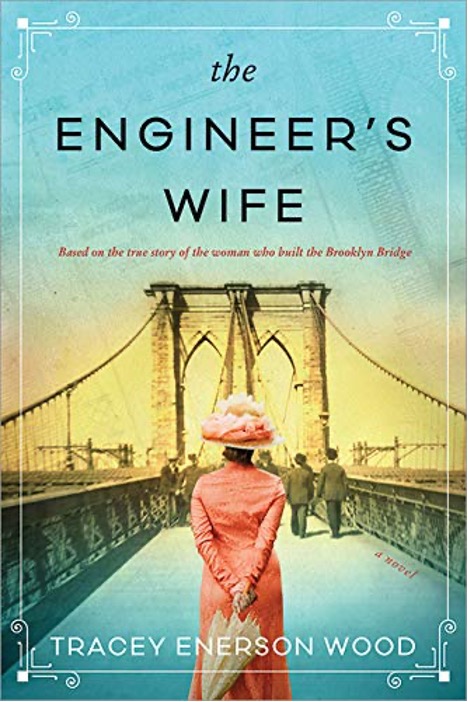
For over hundred years the Brooklyn Bridge has been recognized as an iconic symbol of New York and an example of American ingenuity and innovation. The Engineer’s Wife, a novel by Tracey Enerson Wood, examines the significant role that Mrs. Emily Warren Roebling, the wife of the chief engineer of the Brooklyn Bridge Project, had in construction of the bridge.
Born into a large middle-class family in Cold Spring, New York, Emily did not aspire to follow a stereotype of a society woman whose life revolves around husband, children, and the house. Her goal was to join the suffrage movement and work to achieve equal rights for women. However, soon after Emily met and subsequently married Washington Roebling, her older brother’s aide during the Civil War, she put her suffragette dreams on hold to take an active role in his work.
Midway through construction of the Brooklyn side of the bridge’s foundation Roebling was struck by a devastating disease that affected many workers exposed to high air pressure inside the caisson positioned deep under water. Temporarily paralyzed and suffering from extreme muscle pain, Roebling refused to resign and asked Emily to be his “eyes and ears” at the construction site. Emily reported to her husband any issues or problems with the construction, and carried back his orders to the workers on site.
After making dozens daily trips back and forth between the house and the building site, Emily, an energetic and gregarious woman, decided it would be more expedient for her to ride on a horseback, rather than sit in a carriage. While ladies of the time rode horses for exercise, Emily’s horse riding on the streets of Brooklyn provoked comments of a “behavior unbecoming a lady” from both neighbors and bridge workers alike. Recognizing that providing Roebling “second hand” information about conditions inside the caisson was insufficient, Emily decided to climb down the long chute into a dark, hot, waterlogged caisson. Because her skirts did not fit inside the narrow chute, Emily decided to wear bloomers: a combination of long pantaloons and a short skirt introduced by Amelia Bloomer, an advocate for women rights at the time.
Although Emily was able to develop a more accurate idea of the conditions inside the caisson, her actions caused further negative comments from the site engineers and members of the Bridge Company Board of Trustees. Several trustees demanded again Roebling’s resignation since he was incapable of managing construction on the site. However, since building the Brooklyn Bridge was his father’s lifelong dream, Roebling refused to resign and Emily continued her daily work on the site.
Over the next several years during the bridge construction Emily became a de facto manager of the project. She managed suppliers, negotiated contracts, and made decisions on many critical issues that went far beyond traditional education available to women at that time. Recognizing her lack of theoretical knowledge Emily studied Roebling’s Rensselaer University textbooks and self-learned algebra, geometry, and trigonometry, thus enabling her to make independent decisions when Roebling’s condition got worse, or during his frequent absences.
Despite many problems and roadblocks the bridge construction continued. Emily became a public face of the project, but also a subject of fears and superstitions inflamed by the negative press. Initially shy and afraid of public speaking, Emily grew more comfortable while discussing important issues with the Board. Several trustees, who initially disparaged her for lack of “education and expertise” and for being a “woman doing a men’s job,” eventually came to recognize and respect her as the project leader.
Thirteen years later as the project was nearing completion Emily began to ponder whether her marriage would survive past Roebling’s frequent absences, and his growing detachment from her and the project. She also wondered whether her hard work would be ever recognized or forgotten in the future.
Based on a true story and extensive archival research, The Engineer’s Wife delivers a poignant portrait of a woman who rose to the challenge “light years” ahead of the education and expectations from women of her class. Emily persevered despite many setbacks and losses, and she walked at the head of the parade celebrating the opening of the bridge for the public. There is a small plaque on one of the Brooklyn Bridge towers that recognizes Emily Roebling’s role in the construction.






